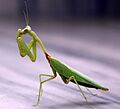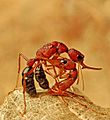Fauna of India facts for kids
India is an amazing country with some of the most diverse nature on Earth! It has many different types of environments, like deserts, tall mountains, thick forests (both tropical and temperate), swamps, plains, and even islands. This means India is home to a huge variety of plants and animals.
India is so special that it has four "biodiversity hotspots." These are places with a lot of different species, and many of them are found nowhere else in the world. These hotspots are the Himalayas, the Western Ghats, the Indo-Burma region, and Sundaland (which includes a group of islands).
Most of India is part of the Indomalayan realm, which is a large area of Asia with similar plants and animals. The very high parts of the Himalayas are part of the Palearctic realm, which includes Europe and northern Asia. India is one of 17 "megadiverse countries," meaning it has a huge number of different species. For example, about 7.6% of all mammal species, 12.6% of all bird species, and 11.7% of all fish species in the world live in India!
India's weather, especially the summer monsoons, greatly affects its plants and animals. Many species in India are similar to those found in Malaysia. However, some species are unique to India, like the Uropeltidae snake family found only in the Western Ghats and Sri Lanka. Fossils show that ancient animals in India were linked to islands like the Seychelles and Madagascar. This is because India was once connected to Africa and Madagascar before continental drift moved it.
People in India have studied and recorded its plants and animals for a very long time, both through traditional stories and scientific research. Today, a small part of India's total land area (just under 5%) is set aside as protected areas to help save its wildlife.
India is famous for its large mammals, such as the Asian elephant, Bengal tiger, Asiatic lion, leopard, and Indian rhinoceros. These animals are very important in Indian culture and are often linked to gods and goddesses. They also attract many tourists, which helps fund conservation efforts. For example, Project Tiger started in 1972 to protect tigers and their homes, and Project Elephant began in 1992 to help elephants. Most of India's rhinos live in the Kaziranga National Park.
Other well-known large mammals in India include the water buffalo, nilgai, gaur, and many types of deer and antelope. Wild dogs like the Indian wolf, Bengal fox, golden jackal, and dhole are also common. India is also home to the striped hyena. Many smaller animals, like macaques, langurs, and mongooses, are often seen living near or even inside cities.
Contents
Amazing Animal Diversity
Scientists are still learning a lot about the smaller animals and insects in India. However, we already know a lot about many groups, especially insects like butterflies and dragonflies.
- About 2,546 different types of fish live in India's waters, which is about 11% of all fish species worldwide!
- India has around 197 species of amphibians (like frogs and salamanders) and over 408 species of reptiles (like snakes and lizards). Many of these amphibians are found only in India.
- There are about 1,250 different bird species in India, making up about 12% of the world's birds.
- India is home to about 410 mammal species, which is nearly 9% of all mammal species globally.
- India has more types of wild cats than any other country!
The World Conservation Monitoring Centre estimates that India has around 15,000 species of flowering plants.
Special Places for Nature: Biodiversity Hotspots
The Western Ghats: A Mountain Range Full of Life
The Western Ghats are a long chain of hills along India's western coast. Because they are close to the ocean, they get a lot of rain. This creates lush moist forests and rainforests. This region is incredibly diverse, with many species found nowhere else. For example, nearly 77% of its amphibians and 62% of its reptiles are unique to the Western Ghats!
Scientists have studied how animals and plants in the Western Ghats are related to those in other parts of Asia, like the Malay Peninsula, and even Madagascar. Some unique animals, like the purple frog, show these ancient connections.
The Eastern Himalayas: A Young Mountain Wonderland
The Eastern Himalayas include parts of Bhutan, northeastern India, and Nepal. This mountain range is geologically young and has huge changes in height, from low valleys to very high peaks. This creates many different habitats.
This region is home to about 163 species that are globally threatened, meaning they are at risk of disappearing from the planet. These include the one-horned rhinoceros, the Wild Asian water buffalo, and many mammals, birds, reptiles, amphibians, and plants. A very rare dragonfly, Epiophlebia laidlawi, lives here, and its only close relative is found in Japan. The Himalayan newt (Tylototriton verrucosus) is the only salamander species found in India.
Animals and Plants from the Past: Fossils and Extinctions
Ancient India and Its Fossils
Millions of years ago, during the early Tertiary period, what is now peninsular India was a large island. Before that, it was connected to Africa. Later, this island moved and crashed into the Asian mainland, which created the mighty Himalayas and the plains of northern India.
When India connected to Asia, many new species moved into the region. The Siwaliks, a range of hills formed during the last major uplift of the Himalayas, are famous for their many fossils from the Tertiary period. These fossils show that animals like mastodons (ancient elephants), hippopotamuses, rhinoceroses, giraffes, horses, camels, bison, many types of deer and antelope, and even ancient apes like gorillas, chimpanzees, and orangutans once lived here. Big cats like cheetahs, sabre-toothed cats, lions, and tigers also roamed these lands.
Scientists have also found fossils of ancient trees and plants. The discovery of Glossopteris fern fossils in both India and Antarctica helped scientists understand the idea of continental drift and how Earth's continents moved over time.
India is also a place where dinosaurs once lived! Titanosaurus indicus was one of the first dinosaurs found in India in 1877. Another dinosaur, Rajasaurus narmadensis, was a large, meat-eating dinosaur that lived near the Narmada river. It was about 9 meters (30 feet) long and 3 meters (10 feet) tall!
Even ancient whales have been found in India. Himalayacetus subathuensis, the oldest known whale fossil from a certain family, was found in the Himalayan foothills. This area was once under the Tethys Sea, where this whale likely lived.
Animals We've Lost: Recent Extinctions
Sadly, human activities like hunting, trapping, and changing land for farming or cities have caused many species in India to disappear recently.
One of the first animals to vanish was a type of wild cattle called Bos primegenius nomadicus, or the wild zebu. It disappeared from the Indus valley, possibly because it interbred with farm animals and lost its natural habitat.
Other well-known large mammals that are now extinct in India include the Indian cheetah, Javan rhinoceros, and Sumatran rhinoceros. While we know these large animals are gone, it's harder to tell for many smaller animals and plants. Some haven't been seen since they were first described.
Some birds have also gone extinct recently, like the pink-headed duck and the Himalayan quail. However, there have been exciting rediscoveries! A type of warbler, Acrocephalus orinus, was thought to be lost for 139 years but was found again in Thailand. Similarly, the Jerdon's courser, a bird named after the zoologist who discovered it in 1848, was rediscovered in 1986 after being thought to be extinct.
How Many Species? Estimates for India
Scientists try to estimate how many different species live in India. Here's a quick look at some numbers (based on a 1998 study by Alfred):
| Type of Animal | World species | Indian species | % in India |
| PROTISTA (Tiny Organisms) | 31250 | 2577 | 8.24 |
| ANIMALIA (Animals) | |||
| Sponges (Porifera) | 4562 | 486 | 10.65 |
| Jellyfish & Corals (Cnidaria) | 9916 | 842 | 8.49 |
| Worms (Platyhelminthes) | 17500 | 1622 | 9.27 |
| Roundworms (Nematoda) | 30000 | 2850 | 9.5 |
| Snails & Shells (Mollusca) | 66535 | 5070 | 7.62 |
| Segmented Worms (Annelida) | 12700 | 840 | 6.61 |
| Insects & Spiders (Arthropoda) | 987949 | 68389 | 6.9 |
| Crustaceans (Crustacea) | 35534 | 2934 | 8.26 |
| Insects (Insecta) | 853000 | 53400 | 6.83 |
| Spiders & Scorpions (Arachnida) | 73440 | (Many) | 7.9 |
| Fish (Pisces) | 21723 | 2546 | 11.72 |
| Amphibians (Amphibia) | 7533 | 350 | 4.63 |
| Reptiles (Reptilia) | 5817 | 456 | 7.84 |
| Birds (Aves) | 9026 | 1232 | 13.66 |
| Mammals (Mammalia) | 4629 | 390 | 8.42 |
| Total Animals | 1196903 | 868741 | 7.25 |
| Grand Total (Protista + Animals) | 1228153 | 871318 | 7.09 |
Lists of Indian Species
Want to learn more about specific animals in India? Here are some links to lists of different species:
Invertebrates (Animals without backbones)
- Molluscs (like snails and slugs)
- List of non-marine molluscs of India
- Arachnids (like spiders and scorpions)
- Spiders of India
- Insects
- Dragonflies and Damselflies (Odonata)
- Dragonflies and damselflies of India
- Butterflies and Moths (Lepidoptera)
- Butterflies of India
- Papilionid butterflies of India
- Pierid butterflies of India
- Nymphalid butterflies of India
- Lycaenid butterflies of India
- Hesperid butterflies of India
- Riodinid butterflies of India
- Moths of India
- Butterflies of India
- Ants (Hymenoptera)
- Ants of India
- Dragonflies and Damselflies (Odonata)
Vertebrates (Animals with backbones)
- Fishes of India
- Amphibians of India
- Reptiles of India
- Snakes of India
- Birds of South Asia
- Birds in India
- Mammals of India
Images for kids
-
Illustration of a Himalayan quail from A. O. Hume's work. Last seen in 1876
-
Deccan mahseer Tor khudree







